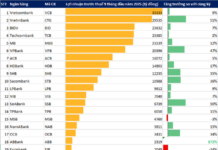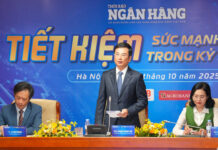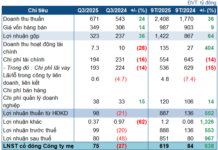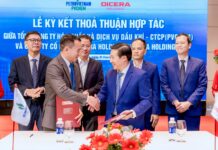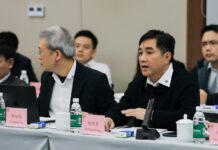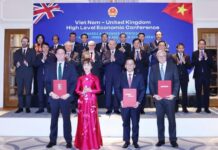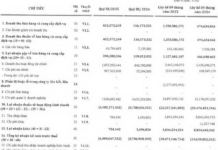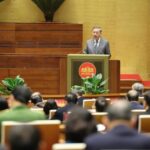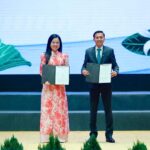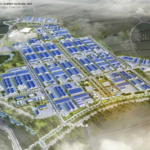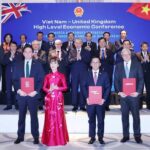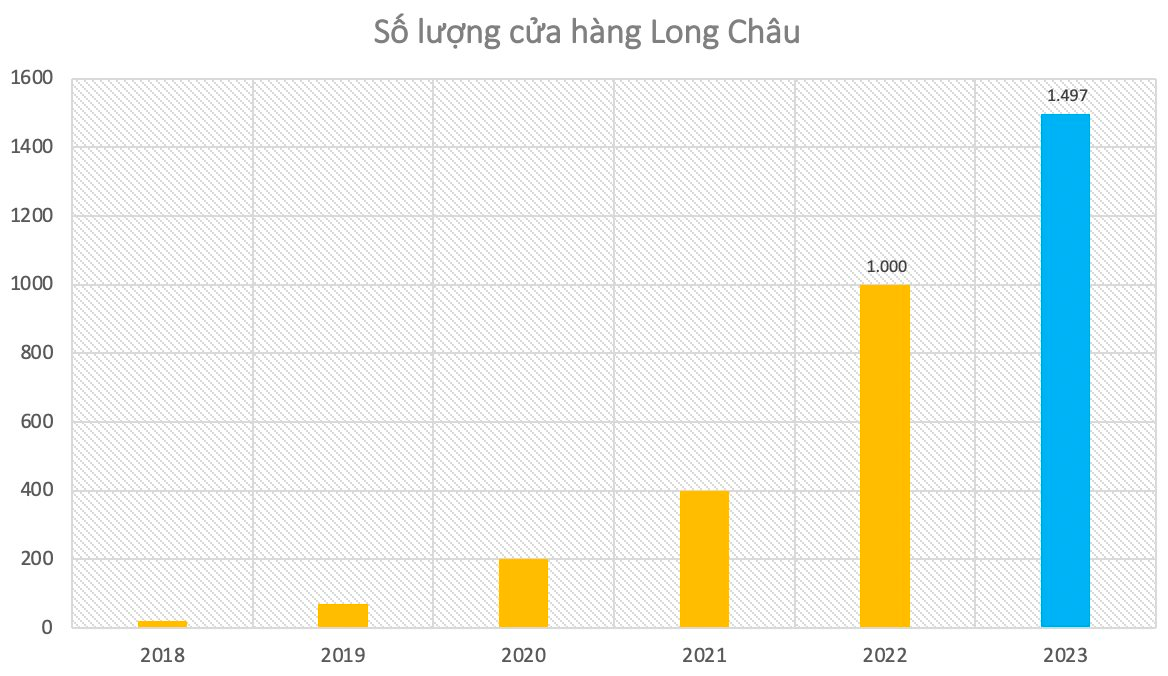On January 13, in Hanoi, the Politburo and the Secretariat of the Party Central Committee held a national conference on breakthroughs in science, technology, innovation, and national digital transformation, with 15,345 online participants across the country and live coverage on VTV1 channel of Vietnam Television.
The conference aimed to assess the implementation of resolutions of the Party Central Committee, the Politburo, and the Secretariat on the development of science and technology; promulgate and deploy Resolution No. 57-NQ/TW dated December 22, 2024, of the Politburo on breakthroughs in science, technology, innovation, and national digital transformation, creating a breakthrough in awareness and implementation, contributing to the country’s prosperous and powerful development in the new era – the era of national advancement.
General Secretary To Lam attended and directed the conference at the Central point.
“Comrades leaders, former leaders of the Party, State, and Vietnam Fatherland Front.
Intellectuals, scientists, entrepreneurs, and all delegates attending the conference at the Central Hall and the online meeting points.
On May 18, 1963, at the historic Ba Dinh Hall, the First Congress of the Vietnam Association for Science and Technology Dissemination was held, marking an important event in the history of science and technology in our country. President Ho Chi Minh, in his speech at the Congress, emphasized the importance of disseminating science and technology, considering it the driving force for national construction and development. He instructed: “Science and technology must be linked to production and serve the people.” This event laid the foundation for the development of science and technology to serve the industrialization and modernization of the country.
More than six decades later, today, the Second National Conference is being held, with a new scale and stature, reflecting the determination of the entire political system and the country in promoting the development of science, technology, innovation, and digital transformation.
As we all know, science and technology are the key drivers of miraculous economic growth in many countries. The success stories of the United States, China, Germany, Japan, and more recently, India, Ireland, South Korea, and Singapore have proven the role of science and technology. These nations have harnessed technology to transform their economic models, boost labor productivity, and enhance global competitiveness.
With the goal of becoming an industrialized country by 2030 and a developed and high-income country by 2045, we must consider science, technology, innovation, and digital transformation as the key drivers. This is the “golden key” and the critical factor for escaping the middle-income trap and the risk of falling behind, while realizing the aspirations for a strong and prosperous nation. However, the development of science, technology, and digital transformation is merely a “means” to achieve this end. Breakthroughs and innovations are the magical elements that lead to miracles, as they create revolutionary advancements, break through current barriers and limitations, and achieve outstanding and prominent results. Breakthroughs bring about novelty, effectiveness, boundary-crossing impacts, and significant influences (for example, in technology: the advent of smartphones has revolutionized how people communicate and work; in economics: business models based on digital platforms such as Uber, Airbnb, and e-commerce have disrupted traditional industries; CRISPR gene-editing technology is a breakthrough in biology, medicine, and agriculture; and in society, reforms in education, healthcare, literature, and arts, and management are bringing about significant improvements in people’s quality of life)
Resolution 57 of the Politburo has outlined strategic orientations, and has been widely supported by officials, party members, scientists, and the business community at home and abroad, as a “quota 10” in the field of science and technology. This support demonstrates the strong development aspirations and determination of our nation. Today’s conference reflects the sense of responsibility and unity of the entire Party and political system. With careful preparation, we strongly believe that breakthroughs in science, technology, innovation, and digital transformation will be the key to taking our country further on the path of realizing our development aspirations.
Comrades and delegates,
Our Party and State have always considered science and technology as a decisive factor and foundation for the country’s sustainable development. Since the Fourth Party Congress, science and technology have been identified as a revolution, and now, as a top national policy. Many important resolutions such as Resolution 20, Resolution 52, and Resolution 36 have been issued, contributing positively to the country’s development as it is today. However, looking at it comprehensively, seriously, and objectively, the implementation of the Central Committee’s resolutions has not achieved the set goals, nor has it met expectations or development requirements.
There are still many shortcomings, limitations, barriers, and bottlenecks hindering the development of science and technology, as mentioned in the report, ranging from institutions, mechanisms, policies, and laws to resources and means (scientists spend too much time, about 50% of their time and effort, on administrative procedures; research topics lack breakthroughs and measurable results; resources for science and technology are limited, with research and development spending accounting for less than 0.7% of GDP, while the average for developed countries is 2%, and some countries spend up to 5%; there is a lack of boldness in accepting risks in research, and products are not commercialized, with many cases of formalistic “economic research”…)
The main reason for the lack of success in implementing the Central Committee’s resolutions lies in the implementation process. Resolution 57 does not replace previous resolutions, but can be considered a “Resolution for Liberating Scientific Thinking,” a “Resolution for Implementing Resolutions,” and a “Resolution for Action,” with very specific goals, aiming to renew thinking and practices, realize the guidelines, remove barriers, and unleash capabilities to promote breakthroughs in the development of science, technology, innovation, and digital transformation, thereby building a strong foundation for the country’s development in the new era.
How can we effectively and promptly turn this Resolution into reality? All levels, sectors, and localities must roll up their sleeves and get to work immediately, without delay. The guidelines and solutions must be quickly institutionalized and prioritized in resource allocation for implementation.
In this regard, I propose to continue studying, improving, and deepening some viewpoints and orientations as follows:
First, regarding viewpoints: Always uphold the view that investing in science, technology, innovation, and digital transformation is a long-term strategy, accepting delays and risks in implementation. Consider this as an investment, and investments entail wins and losses. View data as a new resource, the “air and light” of the new era, and a new means of production; regard digital transformation as a tool to innovate production and business models and renew the productive forces. Innovation is the “magic wand” to achieve sustainable prosperity, with scientists at the center.
Breakthroughs must be pursued in both natural and social sciences, as these are vast spaces with many untapped opportunities for intellectuals, scientists, and workers to turn “stones into bread.” However, for now, we should focus on the following fields: Physics and Energy (quantum mechanics for applications such as microprocessors, lasers, and nano…); Information and Communication Technology; Medicine and Biology (DNA, Genes, Vaccines, 3D…); Space Technology; Materials, Energy, and Environmental Technology (renewable energy, Lithium-Ion Batteries, Carbon Capture and Storage…); Inventions in Daily Life (3D, Robotics and Automation, Virtual Reality – VR, and Augmented Reality – AR); Blockchain Technology, Internet of Things (IoT); Geospatial Information; Digital Culture Analysis; Online Education and Training…
We need to shift from technology application and mastery to building breakthrough innovation capabilities, seizing opportunities from the Fourth Industrial Revolution to “shortcut and lead” the future. The implementation of the Resolution must focus on practical issues that the country is facing and what the market and the economy need. Research products must be commercialized and copyrighted.
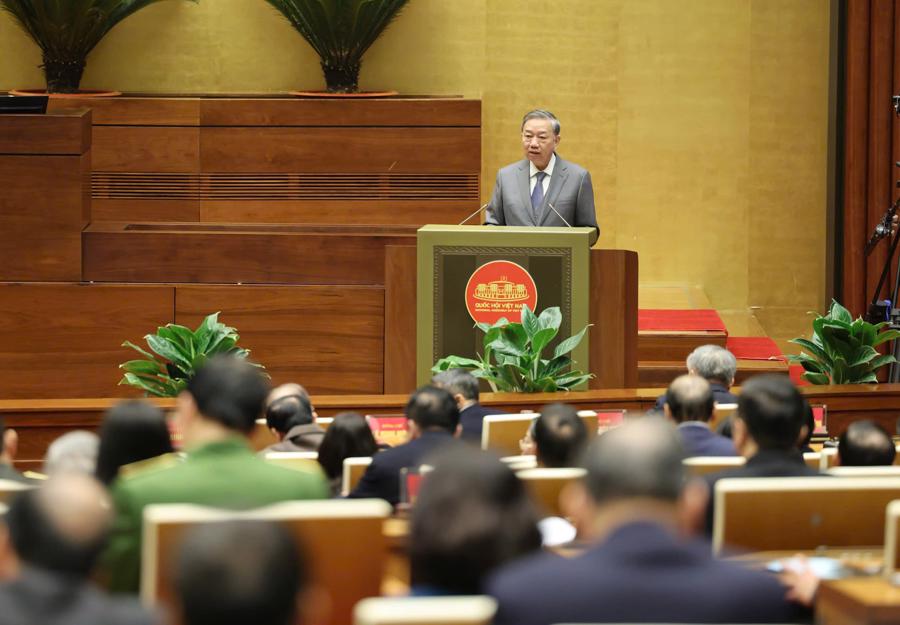
In terms of actions, we need to clarify what the State, enterprises, intellectuals, and scientists should do, and how the people will benefit. The State should focus on four tasks: (1) Improve the institutions and legal framework to facilitate breakthroughs and development, (2) Build infrastructure to support breakthroughs, (3) Develop a diverse and talented human resource pool to drive breakthroughs, and (4) Ensure information data security, secrecy, and intellectual property rights, safeguard national sovereignty, and promote independent development.
With this in mind, I propose and emphasize the following eight tasks and solutions, especially the breakthrough ones:
First, unify awareness and actions: Identify the development of science, technology, innovation, and digital transformation as a strategic task of the entire Party, people, and army. The Central Committee has set an example by taking action, with an accompanying Program of Action promulgated today. Party committees and authorities need to concretize the Resolution through practical plans, using implementation results as criteria for evaluating emulation and commendation. All tasks will be regularly monitored and evaluated; those who perform well will be commended, and those who perform poorly or make mistakes will be criticized and handled. Ineffective and irresponsible leaders will be replaced immediately, ensuring that the country does not miss development opportunities. Party committees, authorities, and units should develop specific plans, closely following the goals of Resolution 57, with clear tasks, specific assignments, timelines, and measurable results. In 2025, we need to address very fundamental issues, creating a foundation for the 2026-2030 period, boosting labor productivity, and building trust in society.
Second, promptly improve the institutions and policies: In 2025, as soon as possible, complete the revision, supplementation, or promulgation of new legal regulations, mechanisms, and policies to remove bottlenecks and barriers to the development of science, technology, innovation, and digital transformation, maximizing creativity and encouraging daring to think, dare to do, and take responsibility (any regulations that need to be removed should be removed, and any laws that need to be amended should be amended promptly, in a synchronized, consistent, and flexible manner. There should be only one content regulated by one law. We need a new mindset and approach in amending the Law on Information Technology, the Law on Science and Technology, the Law on State Budget, the Law on Management and Use of Public Assets, and the Law on Civil Servants, harmonizing related legal provisions). We encourage dynamic and creative individuals who dare to think and dare to do, first and foremost, through legal regulations, creating a space for managers to decide and take responsibility.
The Politburo has oriented the innovation of legal drafting procedures to ensure flexibility and effectiveness, and this spirit will be institutionalized in the Law on Amending the Law on Promulgation of Legal Documents, expected to be passed by the National Assembly soon. The Party Committee of the Government should coordinate with the Party Delegation of the National Assembly to direct the timely development of 27 laws and 19 decrees in 2025, ensuring the institutionalization of Resolution 57 of the Politburo and the early issuance of guiding documents for the new regulations to be implemented in practice. Improving the institutions must go hand in hand with effective implementation, with a mechanism for strict supervision and evaluation, especially for the implementing officials. Immediately eliminate the “carpet-rolling” mentality and the mindset of term limits, jealousy, or egalitarianism.
Third, promptly reorganize the science and technology apparatus: In the first quarter of 2025, complete the reorganization of science and technology organizations; focus investments on developing strong research institutions. Have a concrete plan to build a high-quality human resource pool, especially scientific talents. Implement breakthrough solutions to attract leading technology corporations and Vietnamese and foreign technology talents to work in Vietnam. The procedures related to this must be truly more flexible and even highly competitive compared to other countries to attract them. Consider removing business conditions that are no longer suitable for the new requirements of Resolution 57. The State may consider piloting the appointment of outside experts as leaders in some institutes or schools, especially among overseas Vietnamese who understand Vietnamese culture, have grown up in developed countries, are knowledgeable in their fields and management, and have extensive international connections. In the past, they were reluctant to return because we were not truly welcoming, and there were many administrative barriers and regulations that made it difficult to manage. Now, everything will be much smoother.
Consider forming a mechanism for a Chief Architect or General Contractor for the implementation of large-scale projects and programs in science, technology, and digital transformation that are interdisciplinary; Establish a National Institute for Standards and Testing for research, testing, evaluation, and certification of products and services.
The State should facilitate the establishment of private research institutes, provide procedural support, offer tax and credit incentives, allow the invitation of foreign experts to work, and create all favorable conditions for their operation. (Recently, some large technology corporations intended to invest in Vietnam, but the procedures were too cumbersome, and it took years to implement them due to various obstacles.) This issue must be reviewed and strongly reformed from 2025.
Fourth, prioritize the budget allocation for science and technology commensurate with the breakthrough national policy: Allocate the budget for science and technology, R&D, establish science and technology funds, and encourage the formation of venture capital funds, angel funds, startup funds, and innovation funds, etc. Explore the “public investment-private management” model, ensuring that scientists have autonomy in research and technology application. In 2025, the first year of implementing Resolution 57, the Government needs to innovate in planning the budget allocation for the development of science, technology, innovation, and national digital transformation, and the Government is requested to allocate at least 3% of the budget for this task and continue to increase the proportion of spending on science and technology to 2% of GDP in the next five years. Soon announce this policy and provide convenient guidance on procedures. Review, adjust, and ensure the conformity of schemes and projects with Resolution 57 to avoid wastefulness, focusing on effective and concentrated investment. At the same time, thoroughly reform the processes of budget allocation, management, and settlement, eliminating the “begging” mechanism and cumbersome procedures to optimize resources and encourage creativity.
Fifth, quickly develop high-quality human resources: Promulgate mechanisms to attract talents, especially scientific and technological talents, overseas Vietnamese intellectuals and experts, and international experts, with attractive policies on citizenship, income, housing, and working environment. Related procedures must be flexible, attractive, and competitive internationally. Build a network of domestic and international experts, regularly reporting results to the Central Steering Committee. Promote the movement to honor talents and creativity, arouse the patriotism and dedication of scientists. Continue to maintain the lifelong learning movement and reform the education and training system, focusing on postgraduate, undergraduate, and vocational education.
Sixth, increase investment in technological infrastructure, including digital infrastructure: Prioritize the construction and improvement of infrastructure as mentioned in Resolution 57. In particular, energy infrastructure for the next 5-10 years needs to be prepared, focusing on clean energy, ensuring sufficient energy for development through concrete actions. Optimize and upgrade digital infrastructure, build 5G base stations, expand broadband Internet access, and extend the coverage of optical fiber cables. Develop a low-orbit, high-speed satellite system. Build a National Data Center and implement the Data Law and the Data Exchange Floor in 2025. In 2025, the Party Committee of the Government needs to direct the review and supplement of the Power Development Plan VIII, effectively exploit potentials such as wind and solar power, implement the construction of nuclear power plants, and ensure a sustainable energy source. At the same time, manage, exploit, and protect minerals effectively, especially rare earths, to serve the national development of science and technology.
Seventh, focus on areas with advantages and potential, avoiding dispersion: Prioritize resources for some economically advantageous and potentially developing sectors, avoiding inefficiency and waste, including technological solutions for practical issues in the country such as rational use of resources, environmental protection, climate change adaptation, high-tech agriculture, food security, health sciences, and 4.0 industries. Promote “sharp spearheads” in digital transformation, especially the implementation of Scheme 06 and the construction of the National Data Center. In 2025, ensure that 100% of administrative procedures related to businesses are done online, smoothly, and effectively; 100% of administrative procedures are not limited by provincial administrative boundaries. Accelerate data connectivity and sharing in areas such as population, justice, education, banking, taxation, insurance, enterprises, land, vehicles… The National Data Center must be completed with “accurate, sufficient, clean, and live” data, leading the comprehensive digital transformation, creating a foundation for the development of the digital economy and modern productive forces in the 2026-2030 period, in line with the goals of Resolution 57.
Eighth, promote international cooperation and utilize international knowledge: Promote research cooperation and technology transfer with advanced countries, especially in fields such as artificial intelligence, biotechnology, semiconductors, and renewable energy. Actively participate in the development of international standards, initially within the ASEAN region, through initiatives such as the Hanoi Convention. We must know how to “stand on the shoulders of giants.” Attract investment from large technology corporations, create opportunities for Vietnamese enterprises to participate in global value chains, and encourage technology transfer, enhancing the capacity to learn, absorb, master, and improve the world’s knowledge and technology.
Comrades and delegates,
Our country is facing great opportunities for advancement, but the challenges are also enormous. We must be determined to carry out the revolution in the development of science, technology, innovation, and digital transformation, not missing this opportunity again. I call on the entire Party, people, and army to unite, be creative, and successfully implement the tasks, bringing Resolution 57 to life, building a peaceful, unified, independent, democratic, and prosperous Vietnam, as wished by President Ho Chi Minh.
“Elevating Vietnam-Laos Cooperation: Aiming for a Transformative, Focused, and Impactful Partnership”
Within the framework of his visit to Laos and co-chairing the 47th meeting of the Vietnam-Laos Inter-governmental Committee, on the morning of January 10, in Vientiane, Prime Minister Pham Minh Chinh met with Thongloun Sisoulith, General Secretary of the Lao People’s Revolutionary Party Central Committee and President of Laos.
The Future of Technology: A Visionary Speech by the Secretary-General
General Secretary To Lam emphasized that science, technology, innovation, and digital transformation must be regarded as the “golden key” and vital factors in overcoming the middle-income trap and the risk of falling behind. These areas are also crucial in realizing our nation’s aspirations for strength and prosperity.
“T&T Group Ventures into its First Wind Energy Project in Laos”
The investment in the Savan 1 wind power project not only fulfills T&T Group’s commitment to expanding its clean energy portfolio but also marks a significant milestone as the Group’s first energy venture in Laos. This project underscores the Group’s dedication to ensuring energy security and fostering stronger collaboration between Vietnam and Laos.
“T&T Group’s Inaugural Wind Power Project in Laos: Exporting Electricity to Vietnam from Late 2025”
After entering the construction and operation phase, electricity from the Savan 1 Wind Power Project – the first wind power project of T&T Group in Laos – will be exported to Vietnam. This significant project not only contributes to ensuring Vietnam’s energy security but also strengthens the bond between these two neighboring countries.








